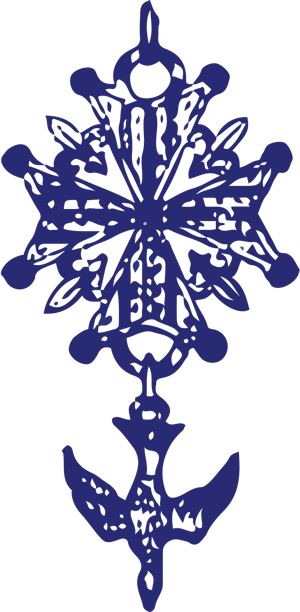History
 The Cross shown here which has been adopted as the insignia of The National Huguenot Society is both beautiful and symbolic. It is not, however, exclusive to the Society. It is being used more and more throughout the world as a sign among the descendants of the Huguenots. Many designs of the Cross have been worn by Huguenots throughout the years. This particular design was discovered by the Reverend Andrew Mailhet in the province of Languedoc, France, and dates from at least the eighteenth century. It has, therefore, become known as the Cross of Languedoc.
The Cross shown here which has been adopted as the insignia of The National Huguenot Society is both beautiful and symbolic. It is not, however, exclusive to the Society. It is being used more and more throughout the world as a sign among the descendants of the Huguenots. Many designs of the Cross have been worn by Huguenots throughout the years. This particular design was discovered by the Reverend Andrew Mailhet in the province of Languedoc, France, and dates from at least the eighteenth century. It has, therefore, become known as the Cross of Languedoc.
It is impossible to know exactly when the Huguenots adopted the Huguenot Cross as a symbol and confirmation of their faith. However, it is believed to have been a sign of recognition among the French Protestants as early as the 17th century. It was patterned after the Order of the Holy Spirit insignia worn by Henry IV of Navarre, who issued the Edict of Nantes in 1598 to protect Protestant freedoms. The Huguenot Society of South Africa provides the following information as to its history:
“The Huguenot cross was designed and first manufactured by a certain Mystre of Nîmes in 1688. It has as its predecessor the badge of the Hospitaler Knights of St John of Jerusalem also known as the Knights of Malta, a religious and Crusader order founded in Jerusalem in the 7th century AD. In 1308 they occupied the island of Rhodes after the collapse of the Crusader states, and in 1530 formed the order of the Knights of Malta after Rhodes was surrendered to the Ottoman Turks. They lived for 4 centuries on the island of Malta, hence the name Maltese Cross for the central part. (The Maltese Cross is generally associated with fire and is the symbol of protection of fire fighters in many countries).”
“Other predecessors of the Huguenot Cross include the so-called Languedoc Cross, and the order decoration of the Order of the Holy Spirit which Henry III established on December 31st, 1578.”
Significance and Meaning
The gold Cross of Languedoc, with the official ribbon of the Society which is white, edged with stripes of French blue and gold has become the official insignia of The National Huguenot Society worn by members. The Cross of Languedoc consists of four elements:
- The insignia consists of an open four-petal Lily of France — reminiscent of the Mother Country of France — in which each petal radiates outward in the shape of a “V” to form a Maltese Cross. The four petals signify the Four Gospels. Each petal, or arm, has at its outside periphery two rounded points at the corners. These rounded points are regarded as signifying the Eight Beatitudes.
- The four petals are joined together by four fleur-de-lis, also reminiscent of the Mother Country of France. Each fleur-de-lis has has three petals. The twelve petals of the four fleur-de-lis signify the Twelve Apostles.
- An open space in the shape of heart is formed between each fleur-de-lis and the arms of the two petals with which it is joined. This shape — a symbol of loyalty — suggests the seal of the great French Reformer, John Calvin.
- A descending dove pendant representing the Saint Esprit or “Sainted Spirit” — the guide and counselor of the Church — is suspended from a ring of gold attached to the lower central petal.
Size
The size of The Cross of Languedoc insignia as used by The National Huguenot Society is normally 1-1/8 inches in height by 1 inch in width, exclusive of the pendant dove. When including the pendant dove the height of the insignia increases to 1-7/8 inches, while the overall width remains unchanged.
This size, however, may be varied based upon need provided that the proportions of 9:8 height to width, exclusive of the pendant dove are maintained. When the pendant dove is included the ratio of height to width must remain at 15:8.


